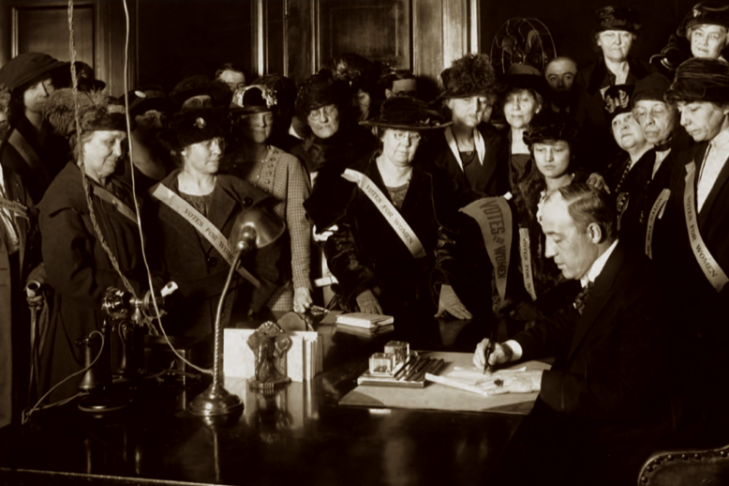Two years ago, as Jonathan Greenblatt stepped into the role of CEO and national director of the Anti-Defamation League (ADL), he was searching for a comprehensive history of the ADL’s century-long involvement in civil rights. “I was looking for a book that told the Jewish experience in fighting for civil rights,” he recently told JewishBoston. “The work of the ADL is not only about fighting for Jewish civil rights. We have fought for immigrants, women and been involved in gender equity issues.”
At a 2015 TED conference, Greenblatt told writer and photojournalist Rick Smolan about his dilemma. Together they realized that they would have to write the book that Greenblatt had envisioned. The result is “The Good Fight: America’s Ongoing Struggle for Justice,” a coffee-table book that includes the civil rights story of struggle and success of nine immigrant groups over the past 100 years. The groups include African Americans, Native Americans, Japanese Americans, Jews, Muslims, the LGBTQ and disability communities, women and Latinos. The well-curated book presents more than 180 photographs—some of them well-known—a dozen essays and 60 embedded videos. Contributors include George Takei of “Star Trek” fame, Pulitzer Prize winner and New York Times columnist Bret Stephens, and Bryan Stevenson, best-selling author of “Just Mercy: A Story of Justice and Redemption” and founder of the Equal Justice initiative.
Smolan, who is known for his “Day in the Life” books, wanted this new book to be more than an accounting of civil rights history. Not only did he want to look back, he was emphatic that the book was also forward thinking. “I was worried that it would be a depressing book full of pictures about lynchings, burials and massacres,” he said. “The challenge was to answer the book’s basic premise of whether Jews, blacks, women and others were better off in 1917 or 2017. No one wants to go back. The book had to reflect in part on how much progress we’ve made in a relatively short period.”
Originally scheduled to be published last year, Greenblatt and Smolan agreed that President Trump’s election was a factor in how they would roll out the book. Greenblatt emphasized that while the book celebrates diverse communities of Americans in words and pictures, “the struggle for the right to be treated equally with dignity and respect still continues today. Whereas in 2015 this was a bit of an abstract notion, today, because of where we are in this country—the political environment, the social environment—the cultural moment for this book is more relevant than ever.”

Smolan added that when President Trump was elected, “all this progress seemed to be in jeopardy again in a way no one could ever imagine. We seemed to be sliding backward. There was a sense of urgency to remind people of just how many hard-fought battles have been won. People risked their lives and their reputations to make America closer to the ideals of our forefathers.”
The book’s tribute to America’s past begins with 10 double-page images illustrating America’s ongoing and positive progress. Among the stunning color photographs are depictions of the Dakota Access Pipeline protest, a scene with the groundbreaking cast of “Hamilton” that portrayed America’s founding story with a racially diverse cast, and a long view of the 2017 Women’s March in Washington, D.C., with the caption stating that in 2017 more than 11,000 women ran for political office, a number that’s up from 800 in 2016.
However, as Greenblatt pointed out, there is much more work to be done. Issues of equality are of concern for Latinos and African-Americans. Greenblatt observed that criminal justice reform has been long delayed and voting rights have been suppressed. The safety and battles of Muslim Americans, he said, “have been front and center because of the policies of this administration. All nine chapters of this book recount the ongoing struggles of different communities. These are fundamental stories about the evolution of our historical experiment and the seismic shifts in this society. It’s a privilege to help kindle this book because it allows us to put faces to names, as well as pictures, words and sounds to the stories we’ve been reading about in the press and social media.”
For Smolan, pairing the photographs with various essays and text has given him an aerial view of history. But Smolan worried that dedicating only 25 pages to tell the story of a people was not sufficient. Making the book interactive solved that problem. Readers can download The Good Fight Viewer at goodfightbook.org and hover a phone over photos in the book that have an orange icon. Those pictures have videos attached to them that elaborate on the image in the book. “It’s like skipping a stone across a lake, and wherever it hits we’re going to tell a story,” said Smolan. “But there’s a whole wake underneath to go much deeper into the content.”
Smolan and Greenblatt want “The Good Fight” to convey a sense of hope. “This has been the hardest book I’ve worked on,” Smolan said. “We went through 27 drafts. I’m grateful to Jonathan [Greenblatt] and the ADL for sponsoring the book. It was a bold thing to put ADL’s 100-year-old history in our hands.” As for Greenblatt, he’s proud of the book’s inclusivity and its innovation. “Everyone in their own way has struggled, and those struggles remain ongoing efforts,” he said. “We’ve made tremendous progress, but there is still more to be done.”



